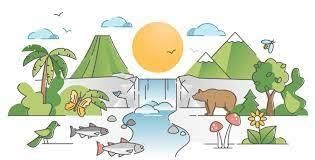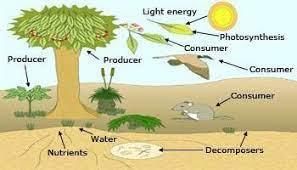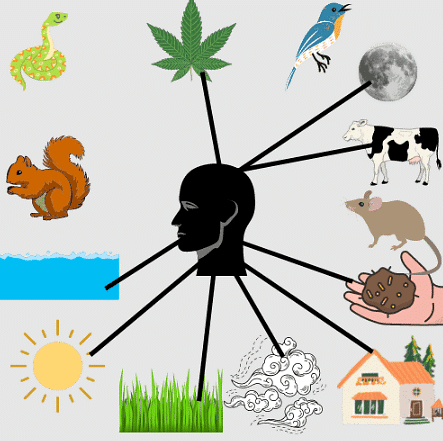Worksheet Solutions: Web of Life - 2 | EVS for Class 3 PDF Download
Q1: Multiple Choice Questions (MCQs).
(i) What is included in the biotic component of the environment?
(a) Soil
(b) Wind
(c) Minerals
(d) Animals
Ans: (d)
Biotic components of the environment include all the living organisms, such as animals, birds, and trees.

(ii) What is the source of the clay used to make bricks?
(a) Mines
(b) Soil
(c) Forests
(d) Oceans
Ans: (b)
Clay, which is used in the making of bricks, is obtained from the soil.
(iii) What does the web created by joining all the things related to us represent?
(a) Our personal preferences
(b) The interdependence of various components of the environment
(c) The food chain
(d) Our family tree
Ans: (b)
The web represents how everything is interconnected and how various components of the environment are interdependent for survival.
(iv) What are the fundamental building blocks of the environment discussed in this chapter?
(a) Water and air
(b) Biotic and abiotic components
(c) Producers and consumers
(d) Rocks and minerals
Ans: (b)
The passage introduces the fundamental building blocks of the environment as biotic and abiotic components.
(v) In an ecosystem, what do producers, consumers, and decomposers represent?
(a) Different types of animals
(b) Different types of plants
(c) Different types of rocks
(d) Different types of organisms
Ans: (d)
The passage mentions that within ecosystems, you'll meet producers (plants), consumers (animals), and decomposers (microorganisms), which are all different types of organisms.
Q2: Fill in the Blanks.
(i) Abiotic components of the environment include ________, wind and minerals.
Ans: Soil
Abiotic components of the environment refer to the non-living physical and chemical elements in the ecosystem. These include soil, wind, and minerals.
(ii) The web created by connecting all the things related to us shows our ________ on them.
Ans: Interdependence
The web showcases the interdependence of various components of the environment, illustrating how we are connected to and dependent on various elements of the ecosystem for survival.
(iii) The ________ we get from rivers, ponds, wells, or rain is used to make bricks.
Ans: Water
Water, which is an essential component of the environment, is used in the making of bricks, along with clay.
(iv) Food webs are the intricate tapestry where multiple ________ interconnect.
Ans: food chains
Biotic components refer to the living elements in the environment, such as plants, animals, and birds. Abiotic components, on the other hand, encompass the non-living elements like soil, wind, and minerals. These two components together form the foundation of the ecosystem, creating a balance between living and non-living factors in nature.
(v) Nature's checks and balances are essential for preserving ________ and maintaining harmony in ecosystems.
Ans: biodiversity
In ecosystems, living organisms (biotic components) interact with their non-living surroundings, or abiotic components. The non-living surroundings can include factors like soil, water, air, and minerals. This interaction is essential for the survival and thriving of all the organisms in the ecosystem, as they depend on these abiotic elements for various resources.
Q3: True or False.
(i) Trees are an example of abiotic components of the environment.
Ans: False
Trees are biotic components of the environment, as they are living organisms.
(ii) We are all interdependent for our survival.
Ans: True
The interdependence of various components of the environment is crucial for our survival. We are connected to and rely on various elements of the ecosystem.
(iii) All webs created by different individuals will look exactly the same.
Ans: False
The webs created by different individuals will differ based on their personal experiences, surroundings, and perceptions of what they deem important for their survival.
(iv) Nature's relationships are simple and straightforward.
Ans: False
The passage mentions that nature's relationships are complex, particularly in the context of food webs.
(v) The chapter emphasizes that human activities do not have any impact on ecosystems.
Ans: False
The chapter emphasizes that human activities can harm ecosystems and have an impact on them.
Q4: Answer the following Questions.
(i) Let’s see, with what other things can we join the house too. Think – What is a house made of?
- Wood – Which comes from trees.
- Bricks – Which are made from water and clay.
- Clay – We get from the soil, and
- Water – we get it from rivers, ponds, wells, or rain.
Ans:
(ii) By now, you must have read almost the complete book. You have read about trees, water, houses, animals, vehicles, and many other things. You must have thought about them as well. Can you tell, why did we try to know and think about all these things?
Ans: All aspects of the environment, such as trees, water, houses, animals, and vehicles, are essential to our survival. As a result, we must be aware of and consider all of the factors that surround us.
(iii) How are we linked to the things shown in the picture? Come, let us find out – Ans:
Ans:
- First of all, draw your picture in the blank space.
- Now, join your picture with lines to all those things which you feel are needed for you to live.
(iv) Have you joined your picture to the house?
Ans: Yes
(v) In the same way, join all the things with other things related to them. While doing so, you might need to write the names of a few more things. What have you finally got? A big web! Isn’t it?
Ans:
(vi) What can you understand from this web?
Ans: The web demonstrates that everything matters to us. For our survival, we're all interdependent on one another.
(vii) Share your web with your friends. Also, have a look at the web made by your friends. Are they all alike? Discuss with your friends.
Ans: All the webs look identical.
|
45 videos|182 docs|48 tests
|
FAQs on Worksheet Solutions: Web of Life - 2 - EVS for Class 3
| 1. What is the web of life? |  |
| 2. How does the web of life contribute to the balance of nature? |  |
| 3. What are some examples of interactions in the web of life? |  |
| 4. How does human activity impact the web of life? |  |
| 5. What can be done to protect and conserve the web of life? |  |
















